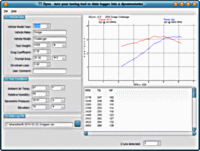
v2015.102
TT Dyno
Dyno software that can turn data logs from automotive tuning
tools into real dyno graphs!
If you have a handheld tuning tool or ECM/PCM data
logger,
you need this software to be able to truly evaluate your mods!
| About |
| Compare |
| Downloads |
| Purchase |
| Support |
| Other Software |

- Dyno your vehicle with your handheld tuner/data logger and TT Dyno software
- Real engine dynamometer: graphs torque/hp for the entire RPM band
- Uses real measurements: no estimates like 1/4 mi or 0-60 HP calculators!
- Less than half the cost of a single session on a chassis dyno
- Not prone to calibration/maintenance errors like a chassis dyno
- Super accurate and consistent dyno graphs and time-to-speed graphs
- Easily dyno any vehicle including 4WD and AWD vehicles
- RPM and vehicle speed are the only required parameters for logging
- Automatically finds multiple runs in a single data log
- Automatic parsing and parameter detection for most popular devices
- Takes into account vehicle weight, weather, wind resistance, and more
- Display knock retard on each dyno graph for tuning purposes
- Compare multiple graphs and export dyno sheet data and graphs
- Free updates for 6 months after initial purchase
- 7 day trial available: test compatibility with your own data logs
v2015.100 released Sep 29, 2014 adds:
- Drive ratio compensation: get comparable graphs in different gears!
- "Mouse over" data reader: just roll your mouse over the graph for numeric data
- Now with more accurate graph smoothing
Get TT Dyno now for only $29.95!
- Fully compatible with Windows 7, Vista, XP, 2000, NT, ME, 98, 95
- Use Fusion or Parallels to run on a Mac. Also runs under Linux/Wine.
From the makers of the popular
Home Dyno and Road Dyno
Use data logs from your handheld tuning
device to get real dyno graphs in an instant!
Already own a handheld tuner or data logger?
Compare:
3 pulls on a chassis dyno: $75 (minimum)
unlimited pulls with TT Dyno: $29.95
Copyright 2010-2014 ddisoftware, Inc.
